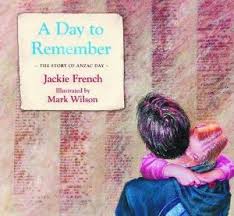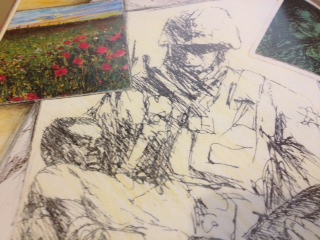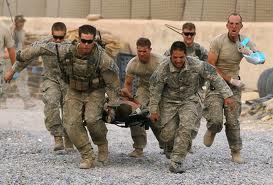Before Reading . . .
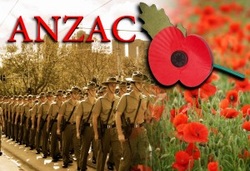
This is a very important book, telling us about the history of Anzac Day. We learn about the memories and experiences that people have about Anzac Day.
What ANZAC services have you been to and why is it important to you?
Discuss the special assembly that we have each year at school and what the children can remember. Why do we have a day to remember all the people who have been to war and given themselves for our country?
What ANZAC services have you been to and why is it important to you?
Discuss the special assembly that we have each year at school and what the children can remember. Why do we have a day to remember all the people who have been to war and given themselves for our country?
|
Look at the front cover.
What is it showing? Look at the picture at the top of this page. It is the wall of remembrance at the War Memorial in Canberra. The name of ever soldier who died in war is on this wall. People visit and place poppies next to names that mean something to them. |
Why do you think this man and the little girl are here?
How is he feeling? What could he be thinking? They have brought a poppy. Who could the poppy be for? Do you think it is a good idea to have a special place to honour people who have fought for their country? Why? |
Click on the following button to visit the website of the Australian War memorial in Canberra.
Time to Read and Discuss
How has the commemoration of Anzac day changed over time?
In ceremonies all around the world what are people all doing?
Is Anzac Day, just for remembering and honouring the bravery of those who fought? Why or why not?
How would you describe the style of Jackie French's writing? Is it factual like a report; descriptive like a story; full of emotion; A combination of these?
How does the language change in the recount of April 1990? Notice the use of "we" and "our" in the language used. How does that make us, the readers, feel? Why would the author use those words? How does she want us to feel?
In ceremonies all around the world what are people all doing?
Is Anzac Day, just for remembering and honouring the bravery of those who fought? Why or why not?
How would you describe the style of Jackie French's writing? Is it factual like a report; descriptive like a story; full of emotion; A combination of these?
How does the language change in the recount of April 1990? Notice the use of "we" and "our" in the language used. How does that make us, the readers, feel? Why would the author use those words? How does she want us to feel?
Look more closely at the pictures
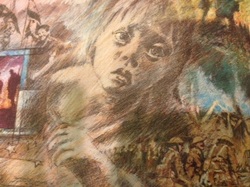
Visual Contact
Visual contact refers to the way a reader views characters in images. Contact can be made through a demand, when the character seems to look at the reader (Eg this picture here), or an offer, when the character seems to look elsewhere. Search the illustrations of A Day To Remember for offer and demand. Which is most prevalent? Why may Mark Wilson have made these choices? How does this visual element add to the meaning of the text? How does it make you feel?
ModalityModality refers to the relative realism of illustrations. Modality can be thought of as a scale from highly realistic to very symbolic or impressionistic. Discuss the modality of the visual text. Are the pictures realistic? Are they too realistic so that they are too confronting or scary? Have they been created in such a way to protect young people or people who are sensitive?
Compare the modality to photographs of similar events. See the two examples below. One is a photograph and the other an illustration of the Afghanistan war. How does the level of modality help readers to absorb the meanings in the book without being too confronted? Discuss with your teacher.
Visual contact refers to the way a reader views characters in images. Contact can be made through a demand, when the character seems to look at the reader (Eg this picture here), or an offer, when the character seems to look elsewhere. Search the illustrations of A Day To Remember for offer and demand. Which is most prevalent? Why may Mark Wilson have made these choices? How does this visual element add to the meaning of the text? How does it make you feel?
ModalityModality refers to the relative realism of illustrations. Modality can be thought of as a scale from highly realistic to very symbolic or impressionistic. Discuss the modality of the visual text. Are the pictures realistic? Are they too realistic so that they are too confronting or scary? Have they been created in such a way to protect young people or people who are sensitive?
Compare the modality to photographs of similar events. See the two examples below. One is a photograph and the other an illustration of the Afghanistan war. How does the level of modality help readers to absorb the meanings in the book without being too confronted? Discuss with your teacher.
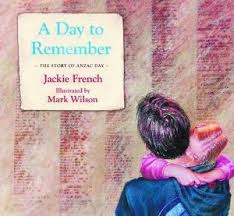
If time permits . . . .
Share the photocopied pages of the text out among the students (Perhaps in pairs).
Circle all the verbs (Action words). Underline all the nouns (Names of things)
Decide whether they are verbs about war or verbs about peace. For example on the first page this is what we found:
This page was more to do with War and not Peace
Share the photocopied pages of the text out among the students (Perhaps in pairs).
Circle all the verbs (Action words). Underline all the nouns (Names of things)
Decide whether they are verbs about war or verbs about peace. For example on the first page this is what we found:
This page was more to do with War and not Peace
|
|
